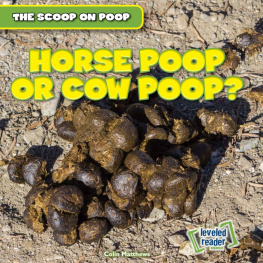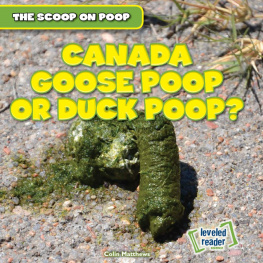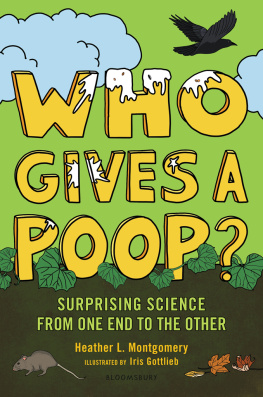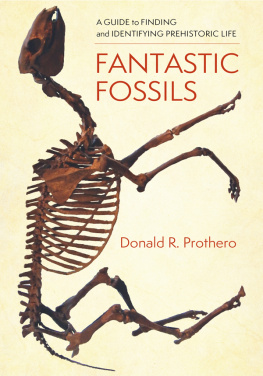Table of Contents
Kristina Lyn Heitkamp
10 1 W. 23rd Str eet
Suite 0
New Y ork , NY 10011
USA
enslo w.com
Enslow
P
ublishing
THE
Power
OF POOP
Titles in the series
Visit enslow.com for more information!
Whether it weighs in at a whopping four pounds or is the size of an egg,
fossilized dung is a precious treasure. Petrifed poop, also known as
coprolite, is rare. But when its discovered, it opens a world into the past.
Trace fossils, such as coprolites, tell stories about how ancient animals and
humans lived, behaved, and even died. Learn how dung detectives identify
and study coprolites. Also explore how fossilized feces are formed.
DIGGING FOR POOP FOSSILS
THE OF P P
Power Power
Poop Can Be a
Time Machine to the Past
ENSLOW
Heitkamp
DIGGING
FOR
POOP
FOSSILS
Kristina Lyn Heitkamp
101 W. 23rd Str eet
Suite
New Y ork, NY 1001
USA
enslow.c om
Enslow
P
ublishing
THE OF P P
Power Power
DIGGING
FOR
POOP
FOSSILS
Words to Know
archaeologist A scientist who studies prehistoric human history
by examining body and trace fossils, as well as other artifacts.
bezoar A stomach stone of indigestible material.
carnivore An animal or human that eats meat.
ecosystem A community of species and plants that interact and
live together in an environment, such as a rain forest.
extinct No longer living.
fossil The preserved remains of an animal or plant from the distant
past.
fossilized Having turned into a fossil.
herbivore An animal or human that eats only plants or vegetables.
paleontologist A scientist who studies prehistoric fossils, such as
dinosaur coprolites.
Contents
Everyone Poops ..........................................................
Left Behind .....................................................................
Fossilized Feces .........................................................
Dung Detectives .......................................................
Waste Is Not Wasted .............................................
From Plants to Poop ...............................................
Disease and Death ...................................................
Peek-a-Poo ...................................................................
The Future of Feces ...............................................
Learn More ....................................................................
Index ..................................................................................
Everyone
Poops
The average person poops roughly once a day
and produces approximately 360 pounds (163
kilograms) of feces a year. Poop is mostly made up
of water, about 75 percent. The rest is made up of
bacteria, which makes turds stinky. Depending on
your diet, poop can be different colors. Beets turn
poop purple, while
carrots or sweet
potatoes give it an
orange hue.
Everyone
poops, even insects
and sh. Animal
poop, also called
scat or droppings,
comes in all shapes
and sizes. Coyote
Whales poop 4 tons (3.6
metric tons) of iron-rich
dung a day that fertilizes
the ocean.
FUN FACT
Poop is usually brown, but some food can turn poop colors.
Spinach or kale makes poop green, and tomato juice can
turn poop red.
Fossil hunter Mary Anning probably used a rock hammer to
dig up fossils found in hard rocks.
scat is tubular and can be several inches long
and full of animal hair. Caterpillars produce tiny
square-shaped droppings found underneath
trees. Cockroaches drop miniscule poop pellets
that look like ecks of black pepper. Tropical
parrot sh poop out tiny grains of coral that
make up the white sandy beaches of the
Caribbean and Hawaii.
With all waste produced by humans and
animals, some poop turns to stone. Old piles
of poo can harden into
fossilized feces, also
known as coprolites. The scientic name,
coprolite, comes from the Greek words
kopros
(dung) and
lithos
(stone). During the early
nineteenth century, a young
fossil hunter
and seller named Mary Anning discovered a
coprolite along the southern shores of Great
Britain. She thought the petried poop was
a
bezoar a stomach stone of indigestible
material. But when she broke it open, the rock
revealed fossilized sh scales and teeth.
Left Behind
In the 1820s, English geologist William Buckland
was digging around in a cave when he stumbled
upon white grape-size blobs that looked like dog
poop. He compared the rocklike stones with
hyena poop at the zoo and discovered the blobs
were the same shape and were made up of the
same minerals. Buckland solved the mystery!
He renamed the blobs coprolites and continued
his journey into the study of ancient poop. He
recognized that coprolites were little treasures
of information.
Buckland worked
with other fossil
collectors, such as
Mary Anning. He
discovered the fossils
of a giant lizard,
which later came to
be known as the rst
discovered dinosaur.
One of the oldest human
hairs was found inside
a hyena coprolite.
FUN FACT
William Buckland spent many years fossil hunting on
horseback in England, Scotland, Ireland, and Wales. He
coined the term coprolite.
Fossilized
Feces
Coprolites form like any other fossil. Once the
poop plops, it can either be destroyed, eaten, or
decomposed. But if it survives, the stinky turd
begins its journey to becoming a mineralized
odorless stone.
When fresh feces falls into soft sediment,
such as mud, and is buried, the layers of sediment
stack up and can turn the feces into a coprolite
over millions of
years. If a poop
drops in a cave, like
the blobs Buckland
found, it is safe
from the elements,
suc h as weather,
and dries out. In
special and rare
Sometimes, animal poo
doesnt take long to fossilize,
just a few hundred years.
FUN FACT
The shape of poop often matches the shape of the intestine.
Corkscrew-shaped coprolites could come from ancient
turtles or prehistoric sharks.
Found in southern Utah, this dinosaur coprolite is from the
Mesozoic era. Thats roughly 252 million years ago!
cases, poop will dry out inside a persons or
animals intestines.
One way to identify a coprolite is by











